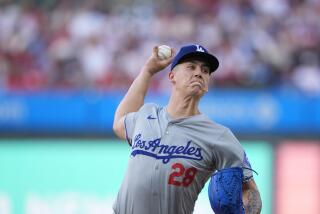Miller takes legacy seriously
- Share via
BEAVER CREEK, COLO. — Before he became a first-name-only star and a newspaper beat, before the disastrous Olympic showing in 2006 and long before Nike turned him into a commercial, Bode Miller’s ability to make headlines was limited to icy ski slopes in obscure winterlands.
Then the millions started rolling in and he became “Bode,” a phenomenon with cult appeal. Little things became big news if he was involved. This off-season was no different.
Today, he will defend his crown on the perilous Birds of Prey downhill course here, the only U.S. stop on the World Cup circuit -- knowing that his journey over the last six months has been nearly as perilous.
It began in May, when, just hours after he ended a decade-long relationship with the U.S. Ski Team, news broke that his 24-year-old cousin had been gunned down after fatally shooting a cop over a small-town grudge in New Hampshire.
Soon after that, amid whispers that he might retire, Miller announced his intention to form an independent squad and compete at his own expense -- an almost unheard-of move by such a high-profile athlete.
Over the summer, Miller, 30, did something else. He quit drinking. It came, of course, on the heels of his notorious exploits at the Turin Olympics, where he entered as a favorite and ended a flop, bludgeoned by the press and casual observers as a waste of the world’s time.
More than a shift in philosophy, Miller’s decision to give up alcohol was a symbol of the approach he has taken this season: With his career winding down and his legacy up for debate, he has committed himself like never before.
He hired his own technicians and a logistics coordinator; even signed on his own PR reps. He has his own coaches now too: respected former U.S. team specialists John McBride and Forest Carey as well as his uncle, Mike Kenney, perhaps the man most responsible for cultivating Miller’s athletic talents.
“Bode’s more responsible now because he’s all in,” says Carey, 31, who raced with Miller in high school. “He’s put everything on the table. It’s his gig.”
Miller has won here the last three years (two downhills, one giant slalom) and recorded his best result of the young season Thursday, a fourth in super combined.
With three more victories -- he won four times last season -- Miller will surpass Phil Mahre’s record for the most wins (27) by an American ski racer on the Alpine World Cup circuit. Judging strictly by the numbers, he will be the greatest racer in U.S. history.
So it seemed a fair question as Miller rode a chairlift between training runs, sporting a straight-ahead stare and his trademark stubble: What does he think of the record?
Miller’s response was vintage Bode. “What record?” he asked, seriously wondering.
To Miller, Mahre’s total means little. “A paper record,” he calls it, citing the fact that in Mahre’s era one could fare well in a downhill and slalom and then get credit for winning a race that didn’t exist, known as the “combined.” In Mahre’s total is 11 such victories, which is why Miller sees himself well ahead.
Is Miller worried, then, that despite his success, he could still be labeled a waste of time? “Why would I worry about that?” he retorts. “I don’t care.”
It’s comments like those that make him such a magnet for criticism. The truth is he cares a great deal. Not about his legacy or image, but about his skiing.
“That’s the thing that goes unnoticed,” Carey says. “His commitment, his hard work. He enters every single race and he brings it every time.”
Long a thorn in the U.S. team’s side, Miller walked into a meeting last spring with team officials and, he says, was told he would not be getting funding for the season. As he puts it, “I was their best guy, I was clearly the most valuable guy on their team for sponsorship and things like that, and they’re asking me to pay to be a part of their team. That just doesn’t equal out.”
Phil McNichol, head coach of the U.S. men’s team since 2003, says team officials talked to Miller about such things as “personal image, respecting the program and the people who work for the program -- coaches.”
In the end, Miller did what has come naturally all his life, following the same impulse that took him from a poor upbringing in the New Hampshire woods to the pedestal of one of the most affluent sports. He declared his independence, committing to spend “half a million dollars,” he says, on what he has dubbed “Team America,” instead of caving to national team demands and racing on their dime.
Despite his independent training, he still must compete as a member of the U.S. squad and wear its uniform in World Cup events, an International Ski Federation rule.
Yet his sponsors remain loyal thanks to Miller’s appeal overseas. In Austria, the epicenter of Alpine ski racing, he carries the same following as homegrown World Cup champions Hermann Maier and Benjamin Raich.
“They love how he does it differently,” said Rainer Salzgeber, race director for Head Skis, an Austrian company that sponsors both Miller and Maier.
And with good reason. Even on the hairiest courses, Miller is seeking that extra mile-an-hour of schuss, the minuscule angle that separates his goal -- perfection -- from everything else.
“I think he’s one of the greatest ski racers the sport has ever seen,” says McNichol, his former coach. “I hope he can do it on his own because he has a lot more potential to achieve.”
More to Read
Go beyond the scoreboard
Get the latest on L.A.'s teams in the daily Sports Report newsletter.
You may occasionally receive promotional content from the Los Angeles Times.






